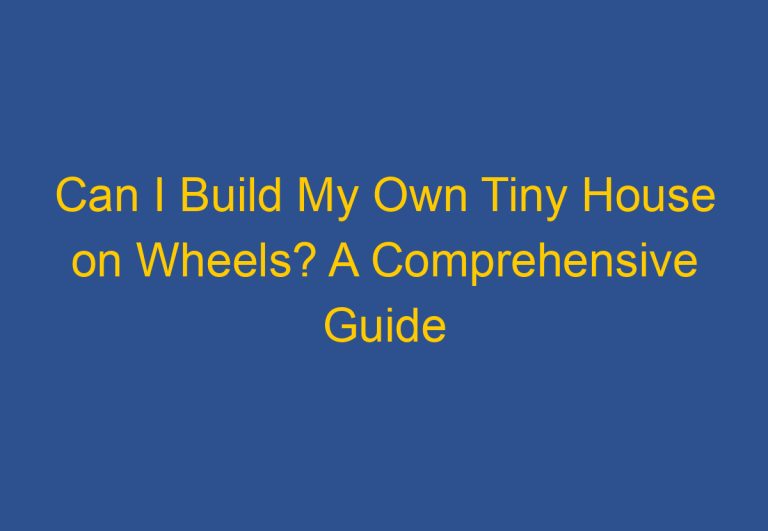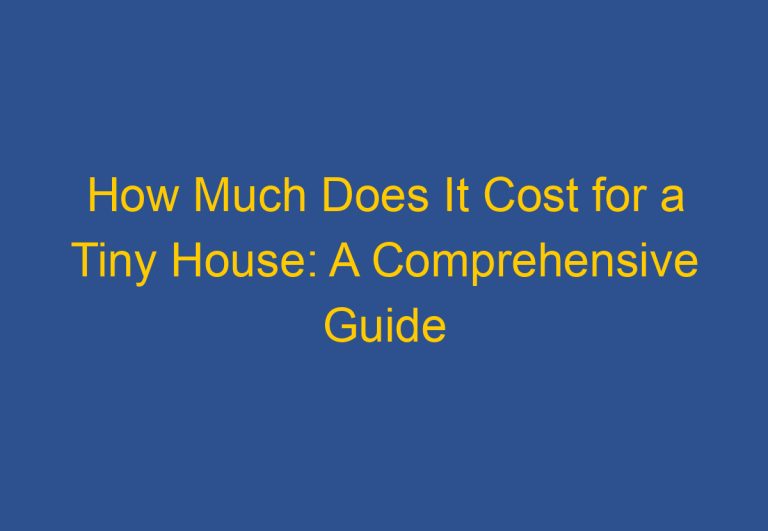Where Can I Legally Live in a Tiny House?
The tiny house movement has been gaining popularity in recent years as more people seek to downsize and live a simpler, more sustainable lifestyle. However, many people are left wondering where they can legally live in a tiny house. Zoning laws and building codes vary by state and even by city, making it difficult to know where to start.
One important thing to keep in mind when considering tiny living is the legal aspect. While tiny homes are often built on wheels and marketed as “RVs,” this doesn’t necessarily mean that they can be parked anywhere. In fact, many cities and towns have specific regulations in place that dictate where and how tiny homes can be placed. It’s important to research the zoning laws and building codes in your area before making any plans.
Despite the challenges, there are many places where it is possible to live legally in a tiny house. Some states, such as California and Texas, have thriving tiny house communities and specific regulations in place to accommodate them. Others may require a bit more research and planning, but with the right information and resources, it is possible to find a legal and sustainable way to live in a tiny house.
Legality and Zoning for Tiny Houses
When it comes to living in a tiny house, one of the biggest concerns is whether it is legal or not. Understanding zoning laws and regulations, building codes, and compliance requirements are essential to ensure that you are living in your tiny home legally.
Understanding Zoning Laws and Regulations
Zoning laws and regulations vary from one municipality to another. Some areas have specific zoning regulations for tiny homes, while others do not. In some cases, tiny homes are classified as RVs, and they are allowed to be parked in RV parks or on private property.
It is important to research the zoning regulations in your area to determine if living in a tiny home is legal. In some cases, you may need to apply for a permit or comply with specific building codes to live in a tiny home legally.
Building Codes and Tiny House Compliance
Building codes and compliance requirements are another essential aspect of living in a tiny house legally. Tiny homes must comply with local building codes, regulations, and safety standards to ensure that they are safe and habitable.
In some cases, tiny homes on wheels are classified as recreational vehicles, and they must comply with specific safety standards. On the other hand, stationary tiny homes must comply with local building codes and zoning regulations, including requirements for foundation, plumbing, and electrical systems.
Tiny Homes on Wheels vs. Stationary Tiny Homes
One of the main distinctions between tiny homes on wheels and stationary tiny homes is the legal requirements. Tiny homes on wheels are classified as RVs, and they are subject to specific regulations and requirements.
On the other hand, stationary tiny homes are considered permanent structures, and they must comply with local building codes and zoning regulations. This includes requirements for foundation, plumbing, and electrical systems.
Accessory Dwelling Units (ADUs) and Tiny Houses
Another option for living in a tiny home legally is to build an accessory dwelling unit (ADU). ADUs are small, separate living units that are built on the same property as a primary residence.
In many areas, ADUs are subject to specific zoning regulations and building codes, but they offer a legal and affordable option for living in a tiny home. It is important to research the regulations in your area to determine if building an ADU is a viable option for you.
In conclusion, living in a tiny home legally requires careful research and compliance with local zoning laws, building codes, and regulations. Whether you choose to live in a tiny home on wheels or a stationary tiny home, it is important to understand the legal requirements and comply with them to ensure a safe and legal living environment.
Living in a Tiny House Community
Living in a tiny house community can be an excellent way to experience the benefits of tiny living while enjoying the support of a like-minded community. Tiny house communities are popping up all over the United States, and many of them offer legal parking options for tiny homes.
Benefits of Tiny House Communities
Living in a tiny house community has several benefits, including access to shared resources, like community gardens, laundry facilities, and recreational spaces. Tiny house communities also offer a sense of community and belonging that can be hard to find in traditional neighborhoods.
Finding Legal Tiny House Parking and Communities
Finding legal tiny house parking can be a challenge, but there are options available. The American Tiny House Association and the Tiny Home Industry Association are excellent resources for finding legal parking options and connecting with other tiny house enthusiasts.
Several states, including Colorado, Texas, California, North Carolina, Oregon, and Florida, have tiny house communities that offer legal parking options for tiny homes. Additionally, some campgrounds and RV parks allow tiny homes to park on their property.
Community Planning and Development for Tiny Living
Community planning and development are essential for creating successful tiny house communities. Careful planning can help ensure that the community is sustainable, safe, and supportive. It’s crucial to consider factors like zoning laws, building codes, and community infrastructure when planning a tiny house community.
Rural areas can be an attractive option for tiny house communities, as they often have fewer zoning restrictions and lower land prices. However, it’s essential to consider factors like access to utilities and services when choosing a location for a tiny house community.
In conclusion, living in a tiny house community can be an excellent way to experience the benefits of tiny living while enjoying the support of a like-minded community. With careful planning and research, it’s possible to find legal parking options and create a sustainable and supportive tiny house community.
Frequently Asked Questions
What are the zoning requirements for tiny homes in various states?
Zoning requirements for tiny homes vary by state and locality. In general, tiny homes are considered to be either RVs or ADUs (Accessory Dwelling Units). Some states have specific laws that address tiny homes, while others do not. It is important to research the zoning requirements in the area where you plan to live to ensure that your tiny home is legal.
Are there any states with particularly tiny home-friendly laws?
Yes, some states have more lenient zoning laws and building codes that make it easier to live in a tiny home. For example, Colorado, Oregon, and California are known for being more friendly towards tiny homes. However, it is important to remember that even in these states, there may still be specific regulations that you need to follow.
What is the minimum square footage required for a dwelling in different jurisdictions?
The minimum square footage required for a dwelling varies by jurisdiction. In some areas, there may be no minimum square footage requirement, while in others, it may be as high as 1,000 square feet. It is important to research the specific requirements in your area to ensure that your tiny home meets the minimum square footage requirements.
How does one obtain a permit for constructing a tiny house on their own land?
Obtaining a permit for constructing a tiny house on your own land varies by jurisdiction. In general, you will need to follow the same process as you would for building any other type of home. This may include obtaining a building permit, submitting plans to the local building department, and having inspections done during the construction process. It is important to research the specific requirements in your area to ensure that you obtain the necessary permits.
Can you reside in a tiny house on a full-time basis across different regions?
Yes, you can reside in a tiny house on a full-time basis across different regions. However, it is important to research the specific zoning laws and building codes in the area where you plan to live to ensure that your tiny home is legal. Some areas may have restrictions on the length of time that you can live in a tiny home, while others may not.
What are the regulations for situating multiple tiny homes on a single acre of land?
The regulations for situating multiple tiny homes on a single acre of land vary by jurisdiction. In general, you will need to follow the same process as you would for building any other type of multi-unit dwelling. This may include obtaining a building permit, submitting plans to the local building department, and having inspections done during the construction process. It is important to research the specific requirements in your area to ensure that you obtain the necessary permits.










